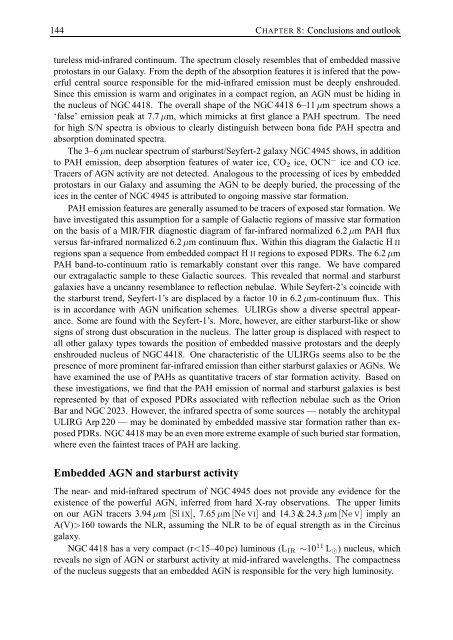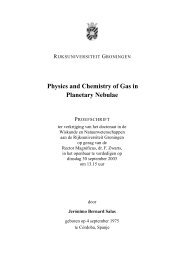Conclusions and outlook - IRS, The Infrared Spectrograph
Conclusions and outlook - IRS, The Infrared Spectrograph
Conclusions and outlook - IRS, The Infrared Spectrograph
You also want an ePaper? Increase the reach of your titles
YUMPU automatically turns print PDFs into web optimized ePapers that Google loves.
144 CHAPTER 8: <strong>Conclusions</strong> <strong>and</strong> <strong>outlook</strong><br />
tureless mid-infrared continuum. <strong>The</strong> spectrum closely resembles that of embedded massive<br />
protostars in our Galaxy. From the depth of the absorption features it is infered that the powerful<br />
central source responsible for the mid-infrared emission must be deeply enshrouded.<br />
Since this emission is warm <strong>and</strong> originates in a compact region, an AGN must be hiding in<br />
the nucleus of NGC 4418. <strong>The</strong> overall shape of the NGC 4418 6–11 µm spectrum shows a<br />
‘false’ emission peak at 7.7 µm, which mimicks at first glance a PAH spectrum. <strong>The</strong> need<br />
for high S/N spectra is obvious to clearly distinguish between bona fide PAH spectra <strong>and</strong><br />
absorption dominated spectra.<br />
<strong>The</strong> 3–6 µm nuclear spectrum of starburst/Seyfert-2 galaxy NGC 4945 shows, in addition<br />
to PAH emission, deep absorption features of water ice, CO 2 ice, OCN − ice <strong>and</strong> CO ice.<br />
Tracers of AGN activity are not detected. Analogous to the processing of ices by embedded<br />
protostars in our Galaxy <strong>and</strong> assuming the AGN to be deeply buried, the processing of the<br />
ices in the center of NGC 4945 is attributed to ongoing massive star formation.<br />
PAH emission features are generally assumed to be tracers of exposed star formation. We<br />
have investigated this assumption for a sample of Galactic regions of massive star formation<br />
on the basis of a MIR/FIR diagnostic diagram of far-infrared normalized 6.2 µm PAH flux<br />
versus far-infrared normalized 6.2 µm continuum flux. Within this diagram the Galactic H II<br />
regions span a sequence from embedded compact H II regions to exposed PDRs. <strong>The</strong> 6.2 µm<br />
PAH b<strong>and</strong>-to-continuum ratio is remarkably constant over this range. We have compared<br />
our extragalactic sample to these Galactic sources. This revealed that normal <strong>and</strong> starburst<br />
galaxies have a uncanny resemblance to reflection nebulae. While Seyfert-2’s coincide with<br />
the starburst trend, Seyfert-1’s are displaced by a factor 10 in 6.2 µm-continuum flux. This<br />
is in accordance with AGN unification schemes. ULIRGs show a diverse spectral appearance.<br />
Some are found with the Seyfert-1’s. More, however, are either starburst-like or show<br />
signs of strong dust obscuration in the nucleus. <strong>The</strong> latter group is displaced with respect to<br />
all other galaxy types towards the position of embedded massive protostars <strong>and</strong> the deeply<br />
enshrouded nucleus of NGC 4418. One characteristic of the ULIRGs seems also to be the<br />
presence of more prominent far-infrared emission than either starburst galaxies or AGNs. We<br />
have examined the use of PAHs as quantitative tracers of star formation activity. Based on<br />
these investigations, we find that the PAH emission of normal <strong>and</strong> starburst galaxies is best<br />
represented by that of exposed PDRs associated with reflection nebulae such as the Orion<br />
Bar <strong>and</strong> NGC 2023. However, the infrared spectra of some sources — notably the architypal<br />
ULIRG Arp 220 — may be dominated by embedded massive star formation rather than exposed<br />
PDRs. NGC 4418 may be an even more extreme example of such buried star formation,<br />
where even the faintest traces of PAH are lacking.<br />
Embedded AGN <strong>and</strong> starburst activity<br />
<strong>The</strong> near- <strong>and</strong> mid-infrared spectrum of NGC 4945 does not provide any evidence for the<br />
existence of the powerful AGN, inferred from hard X-ray observations. <strong>The</strong> upper limits<br />
on our AGN tracers 3.94 µm [Si IX], 7.65 µm [Ne VI] <strong>and</strong> 14.3 & 24.3 µm [Ne V] imply an<br />
A(V)>160 towards the NLR, assuming the NLR to be of equal strength as in the Circinus<br />
galaxy.<br />
NGC 4418 has a very compact (r













